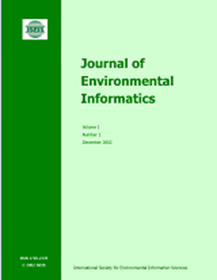利用 CFD 开发和优化用于去除空气污染物的低压微泡洗涤器
IF 5.4
1区 环境科学与生态学
Q1 ENVIRONMENTAL SCIENCES
引用次数: 0
摘要
微气泡洗涤器是一种混合型洗涤器,它结合了普通洗涤器的优点和微气泡的优点。微气泡直径一般在 50 μm 以下,是去除 PM、NOx 和 SOx 等空气污染物的有效方法之一。低压微气泡(LPMB)洗涤器是一种低功耗、高效率的方法,它使用鼓风机将烟气吸入溶液中,利用低压或负压在水中产生微气泡。本研究的目的是通过确定 LPMB 洗涤器产生大量微气泡的最佳运行条件,提高其去除空气污染物的效率。为此,我们开发了一个基于中试规模 LPMB 洗涤器的 CFD 模型,并利用流体流动分析进行了不同运行条件下的案例研究。案例研究包括 12 种情况,根据洗涤器入口和出口之间的压力差(1,000、3,000、5,000 和 7,000Pa)以及初始水位(-0.2、0 和 +0.2 米)来确定。模拟结果表明,最佳运行条件为压差为 5,000 Pa 和初始水位为 -0.2 m。在 LPMB 洗涤器的最佳运行条件下,PM、NOx 和 SOx 的去除率分别为 99.9%、92.6% 和 99.0%。结果表明,所提出的最佳运行条件能有效提高 LPMB 洗涤器的去除效率。本文章由计算机程序翻译,如有差异,请以英文原文为准。
Development and Optimization of A Low-Pressure Microbubble Scrubber for Air Pollutants Removal Using CFD
A microbubble scrubber is a hybrid type scrubber that combines the advantages of a general scrubber with the advantages of the microbubble. Microbubble which has generally under 50 μm diameter is one of the effective ways to remove air pollutants, like PM, NOx, and SOx. The low-pressure microbubble (LPMB) scrubber is a low-power, high-efficiency method that uses a blower to draw flue gas into the solution and generate microbubbles in the water by using low-pressure or negative pressure. The objective of this study was to enhance the removal efficiency of air pollutants in an LPMB scrubber by determining its optimal operating conditions for generating a large number of microbubbles. To achieve this, we developed a CFD model based on a pilot-scale LPMB scrubber and conducted case studies under different operating conditions using fluid flow analysis. The case study consisted of 12 cases according to the pressure difference (1,000, 3,000, 5,000, and 7,000 Pa) between the scrubber inlet and outlet and the initial water level (–0.2, 0, and +0.2 m). The simulation results showed that the optimal operating conditions were a pressure difference of 5,000 Pa and an initial water level of –0.2 m. The removal rates of PM, NOx, and SOx were 99.9, 92.6, and 99.0%, respectively when operating under the optimal operating conditions of the LPMB scrubber. The results suggest that the proposed optimal operating conditions can effectively enhance the removal efficiency of the LPMB scrubber.
求助全文
通过发布文献求助,成功后即可免费获取论文全文。
去求助
来源期刊

Journal of Environmental Informatics
ENVIRONMENTAL SCIENCES-
CiteScore
12.40
自引率
2.90%
发文量
7
审稿时长
24 months
期刊介绍:
Journal of Environmental Informatics (JEI) is an international, peer-reviewed, and interdisciplinary publication designed to foster research innovation and discovery on basic science and information technology for addressing various environmental problems. The journal aims to motivate and enhance the integration of science and technology to help develop sustainable solutions that are consensus-oriented, risk-informed, scientifically-based and cost-effective. JEI serves researchers, educators and practitioners who are interested in theoretical and/or applied aspects of environmental science, regardless of disciplinary boundaries. The topics addressed by the journal include:
- Planning of energy, environmental and ecological management systems
- Simulation, optimization and Environmental decision support
- Environmental geomatics - GIS, RS and other spatial information technologies
- Informatics for environmental chemistry and biochemistry
- Environmental applications of functional materials
- Environmental phenomena at atomic, molecular and macromolecular scales
- Modeling of chemical, biological and environmental processes
- Modeling of biotechnological systems for enhanced pollution mitigation
- Computer graphics and visualization for environmental decision support
- Artificial intelligence and expert systems for environmental applications
- Environmental statistics and risk analysis
- Climate modeling, downscaling, impact assessment, and adaptation planning
- Other areas of environmental systems science and information technology.
 求助内容:
求助内容: 应助结果提醒方式:
应助结果提醒方式:


